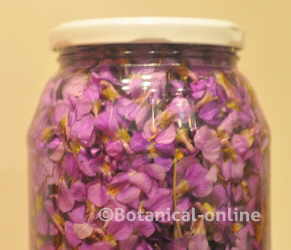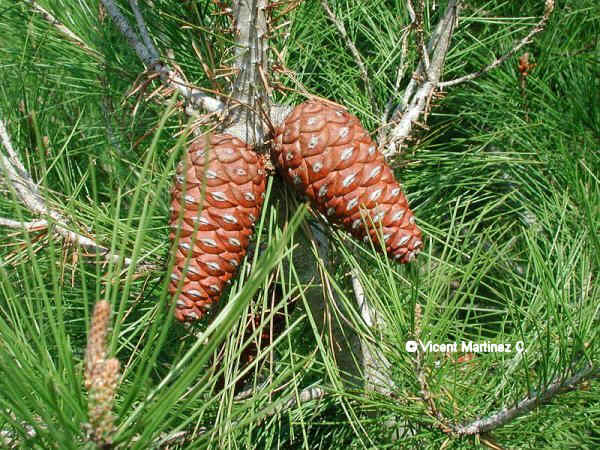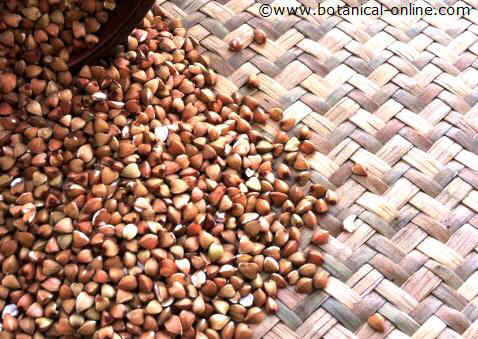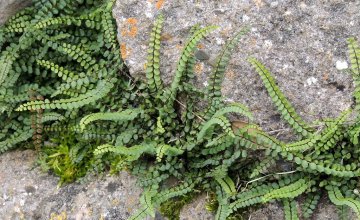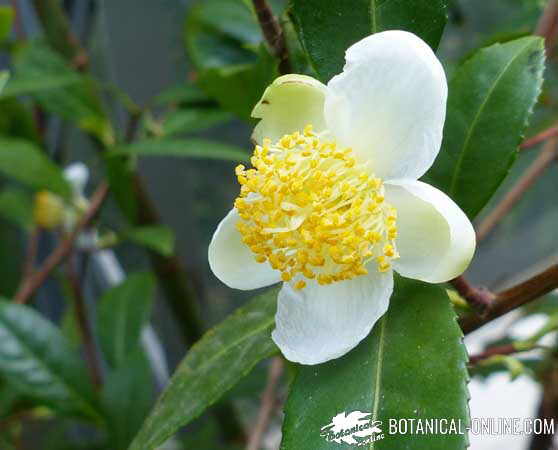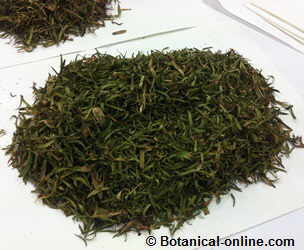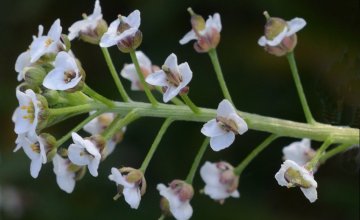Contents
- 1 Health benefits of violet (Viola odorata L.)
- 1.1 Medicinal properties of Viola odorata
- 1.2 Violet internal use herbal preparations
- 1.3 Common violet for respiratory diseases
- 1.4 Violet for the digestive tract
- 1.5 Emetic properties of common violet roots
- 1.6 Diuretic properties of common violet
- 1.7 Violet for the urinary system
- 1.8 Violet external use herbal preparations
- 1.9 Remedies with violet to calm cough
- 1.10 Violet as an anti-inflammatory
Health benefits of violet (Viola odorata L.)
Medicinal properties of Viola odorata
Violet (Viola odorata L.) is a medicinal plant of the same family as pansy. It has emollient and antitussive properties (mainly contributed by its mucilages), sudorific and anti-inflammatory (because of salicylic acid).
The plant is mainly used for its flowers, which are a traditional remedy for respiratory diseases, both in infusion and in syrup. The root is also used, with emetic properties, and the leaves, as an edible plant.
Violet flowers are also used in phytotherapy, along with other medicinal plants, to give aroma and color to many preparations.
Violet internal use herbal preparations
Common violet for respiratory diseases
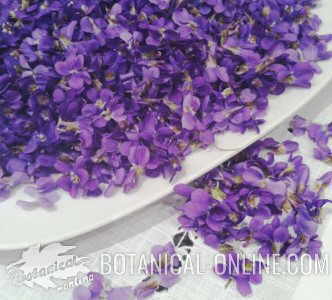
Common violet flowers
Common violet, mainly by its content in mucilage, has soothing, antitussive and anti-inflammatory properties. Moreover, its content in saponins confer expectorant properties, whereas salicylic acid gives analgesic properties.
This same component along with methyl-salicylate, eugenol and beta-sitosterol are responsible for the antipyretic properties, son it can reduce fever. Malic-acid and quercetin provide it with bacteriostatic properties that prevent the growth of bacteria. All this cocktail of properties is particularly used to fight many diseases of the respiratory system, especially in regard to the following anomalies:
- Bronchitis: The properties of the violet are very suitable in case of bronchitis to help the body expel secretions, reduce inflammation and soothe coughing. (Three tablespoons of dried roots per liter of water for 20 minutes. Take 4 tablespoons a day.) (Decoction for a couple of minutes of 1 tablespoon of dried flowers per cup of water. 2 cups a day) (Decoction of 50 g dried root per liter of water for about 10 minutes. Take three cups a day, sweetened with honey)
- Cough: The bechic properties of violet make it well suited to combat coughs, either dry or productive cough. (Infusion of a half teaspoon of dried flowers per cup of water. A couple of cups a day).

Homemade cough syrup. Even more interesting is a homemade cough syrup made with violet flowers and sugar.
* More information on homemade syrup of violets to remove cough) - Fever: The flowers of this plant used in tea help reduce fever. (Infusion of a spoonful of dry flowers per liter of water. (Drink 2 to 4 cups daily)
- Cold: For colds violet infusions with lemon juice helps lessen symptoms. (Infusion of a spoonful of dried flowers per cup of water. Drinking three cups a day with a little lemon juice)
- Influenza: The previous treatment can help make the flu more bearable, especially when the patient presents with thirst attacks or when fever is very high.
- Asthma: the ability of common violet to reduce swollen mucous membranes and their antitussive properties are very interesting for asthma sufferers. Quercetin and scopoletin have antiasthmatic properties. The preparations from this plant can decrease coughing and unswell inflamed airways, which facilitates better breathing for those affected by asthma. (40 drops of tincture daily spread over three daily doses. Tincture of common violet can be obtained from pharmacies or herbalists’)
Violet for the digestive tract
Demulcent or soothing properties of mucilage are suitable for the treatment of some digestive tract abnormalities, such as:
- Gastritis: A tea from dried flowers can help reduce inflammation of gastric mucosa (infusion of one teaspoon of dried flowers per cup of water. Drink two cups a day)
- Gastroduodenal ulcers: The previous preparation is equally useful in the treatment of stomach ulcers and duodenal ulcer. (Infusion of one teaspoon of dried flowers per cup of water. Drink two cups a day)
- Constipation: Malic acid exerts a mild laxative function, effective for the treatment of constipation. (Infusion of a spoonful of dried flowers per cup of water. Drink two cups a day)Increasing the dose, a slightly laxative effect is obtained when needed for a more drastic treatment of constipation.
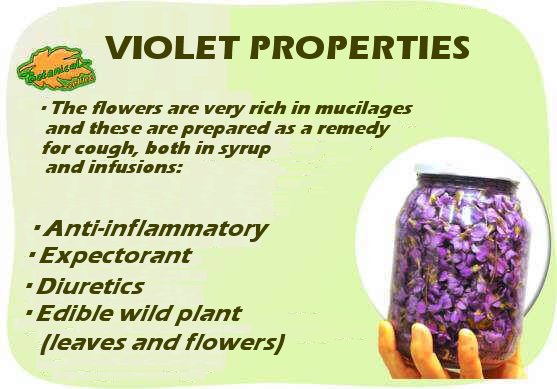
Emetic properties of common violet roots
Violet can be used for combat vomiting (antiemetic) or to to induce vomit, as an emetic. In the first case, we take advantage of the demulcent properties of the mucilage. Saponins, on the contrary, are responsible to cause vomiting when the plant preparations are taken in higher quantities.
Used to induce vomiting, we will make a decoction for 10 minutes of a tablespoon of crushed dried root per cup of water. Once it has boiled all this time, what will approximately evaporate half of water content we will add one tablespoon of sugar. It must be drank little by little with a teaspoon while hot
To avoid vomiting, we’ll make a decoction of a teaspoon of dried flowers per cup of water for about 3 minutes. We will take a couple of cups a day to settle the stomach and remove vomit.)
Diuretic properties of common violet
Cleansing and diuretic properties of violet have been used to increase urination and facilitate the cure of diseases where it is desirable a higher urine production and the elimination of toxins.
In addition, mucilages exert very useful anti-inflammatory properties as an adjunct to the treatment of various kidney diseases.
According to this, it has been mainly used for the treatment of liquid retention in many diseases, such as:
Violet for the urinary system
- Cystitis: For inflammation in the bladder and urinary tract, the use of this plant can help reduce it and expel microorganisms causing the infection. (Infusion of a half teaspoon of dried flowers per cup of water. Drink a cup a day)
- Nephritis: For kidneys inflammation, the previous treatment has similar properties (Infusion of half teaspoon of dried flowers per cup of water. Drink a cup a day)
- Hypertension: By means of increasing diuresis, it favors the elimination of liquids, being suitable for the treatment of hypertension. Moreover, the alkaloids contained in this plant possess hypotensive properties. (Infusion of a half teaspoon of dried flowers per cup of water. Drink a cup a day)
Violet external use herbal preparations
Remedies with violet to calm cough
Mucilages exert an anti-inflammatory effect:
- Pharyngitis: Its soothing and antiinflammatory properties can help relieve discomfort and irritation of the throat in case of pharyngitis. (Make gargles with the infusion of a spoonful of dried flowers per cup of water)
- Sore throat and tonsilitis: Gargles with the same preparation help reduce swollen tonsils and sore throat.
- Decrease dark circles: Violet compresses are applied over the eyes to reduce bags and blepharitis (swollen eyelids) (Infusion of 20g of leaves and / or flowers per half liter of water, let cool and apply to closed eyes)
Violet as an anti-inflammatory
Violet contains numerous analgesic and anti-inflammatory principles (salicylic acid, methyl salicylate, eugenol, beta-sitosterol, quercetin, rutin, etc.) Its properties to fight pain and reduce inflammation can be very effective in the treatment of arthritis, arthrosis or carpal tunnel syndrome.
Used internally decoctions can be made with the dry root, however it is more interesting external use applied to painful joints (Decoction of two tablespoons of crumbled dried root per liter of water for 15 minutes.) Wet a compress with the resulting liquid and apply on the painful area) (Pour the liquid of this decoction into the bath water)
Equally interesting is the violet ointment made with pork lard and violet leaves.
* Related information: Violet traditional uses
![]() More information on violet.
More information on violet.

